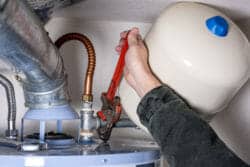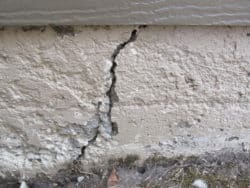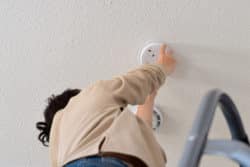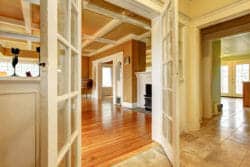Chunks of Concrete Falling Off Exposing Rebar | Seriousness of Spalling
Home » Structural » Concrete slab »

It is not unusual for chunks of concrete to fall off, or spall, exposing rebar. The seriousness of spalling depends on the location and several other factors.
Homeowners and buyers may notice spalling on concrete floors, foundation walls, basement walls, walks, driveways, retaining walls, as well as other locations.
Basically, spalling is the breaking or flaking off of chunks of concrete. However, pieces breaking off also happens with masonry blocks and brick.
When concrete or masonry block spalls, it provides much greater access of water and air to the rebar. This exposure leads to rebar rusting and has an increasingly negative effect on the structural strength of the concrete and rebar.
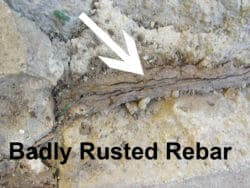
Causes of Spalling
- Moisture and freezing: Porous and cracked concrete allows moisture to penetrate and when the water freezes, it expands approximately 9% in volume; this then causes additional cracks and spalling.
- Concrete coverage over the rebar is too thin: Should there be insufficient concrete over the rebar, the concrete will be more susceptible to cracking and the rebar to rusting.
- Rebar rusting: When rebar rusts it can expand up to 4 times its diameter which puts tremendous pressure on the concrete. This pressure causes the concrete to crack and at times for pieces to fall or break off.
- Concrete in coastal areas may incur salt-laden air, fog, and rain. As the salts dissolve in the rainwater, it penetrates the pores in the concrete. This causes weaker concrete and rebar to rust.
- In areas with snow and ice, products for deicing often contain salts and chlorides which causes rebar corrosion and rust.
- Areas with significant air pollution often have sulfide and sulfate-type contaminants in the air, as well as other chemical elements that corrode rebar.
- Electrochemical reactions: Electrochemical (galvanic) reactions between rebar and the concrete matrix often leads to rebar corrosion and deterioration.
- Mechanical damage: At times if the concrete gets hit hard by metal objects it will chip or crack off.
- Excessive stress: When placed against concrete this may cause cracking, bowing, spalling, etc. This can be caused by:
- Expansive soils (Learn about expansive soils damage to homes)
- Ice lenses (Read how ice lenses crack basement walls)
- slope creep (Discover how slope creep damages homes & concrete)
- Weak concrete: If the concrete does not have enough cement in it or too much water was added when mixing or placing it, then it will be weaker, therefor spalling occurs more easily.
- Other reasons: Workers stepping on or hitting rebar during the pouring of the concrete, earth settlement from the weight of the concrete on soil that was not well compacted; all of which can lead to cracking that allows moisture to penetrate to the rebar which can eventually lead to spalling.
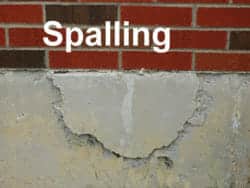
Spalling of foundation walls
Foundation walls that are experiencing spalling should be repaired and monitored. Repairing them will help protect the rebar from moisture and oxidation which may cause additional damage over time.
Checking the foundation for other damage is wise. The check should include checking for rust stains, evidence of foundation movement and geotechnical forces, such as slope creep.
(Photo shows a foundation wall that has an area that is spalling off. Eventually, the loose pieces of concrete will fall off the foundation or wall and will usually expose the rebar.)
Spalling on basement walls

Spalling on basement walls can be serious and should be attended to, for it may be an indication of several serious problems, especially if there are moisture and rusting issues.
There may be high water table issues, drainage issues, soil pressure or expansive soil issues or even a leaking water pipe or sewer.
With moisture, there may be damage to finished basement components, as well as, mold and mildew issues.
Spalling on retaining walls
Retaining walls are usually built with steel-reinforced concrete or reinforced masonry block. When spalling occurs, they begin to lose their structural strength and if severe enough may fail or collapse. Since moisture and cracking often lead to spalling and other damage, retaining walls should be checked from time to time. Rust stains and efflorescence are two of the warning signs that moisture issues exist.
It is wise to remember that when rebar rust, it also begins to lose tensile strength, which is key in the structural integrity of a retaining wall.

The Bottom Line
Damage from spalling generally occurs over a period of years, not days or weeks, thus its importance often gets overlooked. From a structural standpoint spalling in a residential home is usually not a major concern but it’s more of a maintenance and repair issue. However, for basements and retaining walls, more attention should be given.
Structural Engineers will often view spalling as a yellow flag that there may be structural issues or that rebar is rusting and/or a concrete moisture penetration issue exists.
Spalling of concrete on our nation’s bridges, roadways, parking garages, and high-rise concrete buildings is generally considered much more of a concern, than with residential homes, for when concrete chunks break off and rebar rust, there is a risk of structural failure and the endangerment of personal life.
